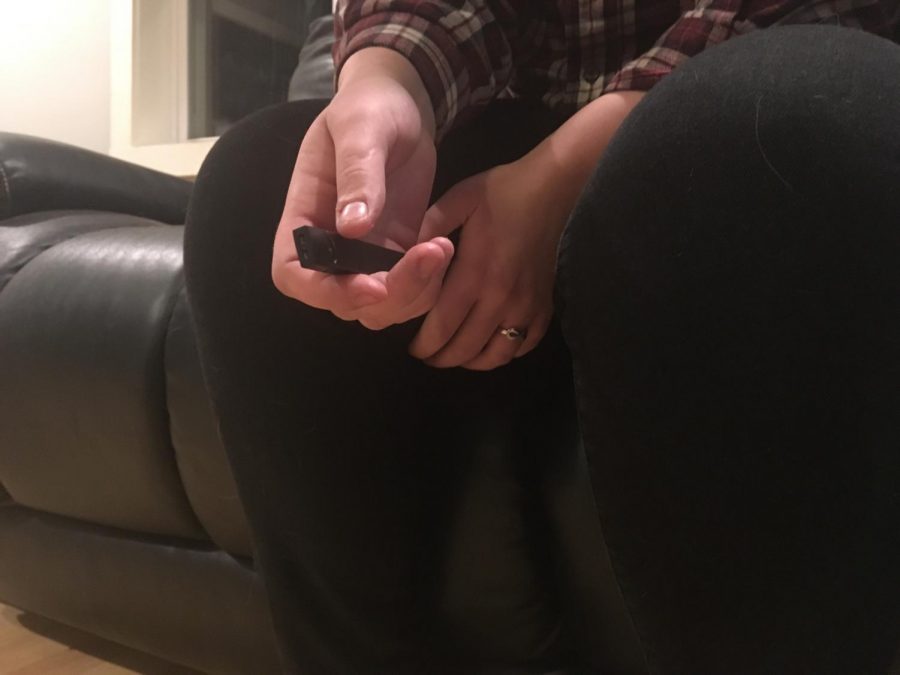PIHS Community Talks About Vaping Among Teens
A PIHS student sits at home, vaping with her friends. PIHS administrators and faculty have increased efforts to create awareness about this risks of vaping recently in response to students’ increased interest in the activity. “They make you think you’re going to get addicted,” Jack Kenney* said.
March 19, 2019
It’s 1982, you’re a PIHS sophomore and you have a pack of cigarettes you bought for 82 cents. During lunch, you head toward the same side of the building as the bus loading zone. After all, that’s the designated spot for high school kids to smoke here on campus.
Fast forward to 2010. You’re an 18-year-old PIHS senior who bought a pack of cigarettes for $5. Before school, you walk across the street and off school grounds to smoke, since it’s now against Maine law to have tobacco products at school.
Finally, it’s 2019. You pull out an electronic device the size of a flash drive that you bought for $35 and hope you don’t get caught as you inhale cotton candy flavored vapor on the Juul.
The issue of teens and smoking is not a new one for any U.S. high school, but students and administrators agree that the vaping epidemic has arrived here, as well.
A vaping device is an electronic cigarette that has nicotine in liquid pods. Teens think it’s not harmful because of the fact that there isn’t the same tobacco smell as cigarettes. According to the Food and Drug Administration (FDA), however, there is still nicotine, as well as other chemicals from the flavor of the Juuls and e-cigarette juice.
This device that was made to help cigarette smokers quit has in actuality become a new gadget that is more likely to cause teens to start smoking, according to a Fact Sheet provided in PIHS homerooms on Wednesday, March 13. Legislators are now trying to play catch-up by putting regulations on vaping, such as requiring companies to turn their flavorful pods into tasteless pods and having age restrictions on the online sites where you can buy them.
PIHS is not immune to this new trend. According to Assistant Principal David Bartlett, 21 percent of high schoolers have tried vaping. Vaping among teens has gone up 78 percent nationally. Just before February break, Bartlett said that so far this year they had confiscated around six or seven Juul or e-cigarettes. Bartlett said that even though that number was low at the time, it represents only the number that was brought to administrators’ attention. “We are always playing catch-up and so is legislation. Right now there are backpacks and hoodies created to hide vapes. It is so easy to hide,” said Bartlett.
Math teacher Jennifer Lapointe, who has taught at PIHS for 37 years, reflected on the evolving culture of smoking at PIHS. “The downstairs teacher’s lounge use to be the area for teachers who wanted to smoke,” she recalled. “And if students wanted to smoke, there used to be this bench where they could.” Lapointe has noticed that kids are not smelling like cigarette smoke as much anymore. She wonders if it’s because parents and students are using e-cigarettes more than combustible cigarettes. Something she has also noticed is that kids are more willing to talk about smoking risks. “People are more open to talking about it and have awareness [of the risks],” Lapointe said. “Society as a whole talks about it, if you have a problem it’s no longer quiet.”
However, even if smoking combustible cigarettes isn’t as widely accepted as it once was, vaping as “acceptable” behavior seems to be taking its place. Authorities are battling misinformation, teen-targeted ad campaigns, and the “cool” factor of a techy device.
Junior Jack Kenney* has tried vaping. He doesn’t do it a lot, but if there is availability he does vape. In total, he says he knows six people who own a vaping device and over 20 people who have at least tried it. He admits that e-cigarettes target a younger generation’s interests. It was also basic business tactics.
“Business are going to do whatever to get their products to sell,” Kenney said. “They pull the attention of teenagers and influence them.”
Kenney thinks that some people overreact, but admits that it is a problem and rapidly growing to younger generations. Compared to traditional cigarettes, though, Kenney said, “Would you rather see your kids smoke normal cigarettes or e-cigarettes? I’m not saying it’s a 100 percent good but which one would you rather see?”
Senior Natasha Lizotte simply doesn’t care about vaping or trying to vape at school. She agrees with most people and thinks that is a problem because kids are now inhaling nicotine younger and younger. She says she only knows one person who vapes, and he is in his twenties.
Lizotte believes that vaping wasn’t made to attract kids in the first place. But then the companies noticed kids had an interest. “They started making sweeter flavors and now they do target kids,” Lizotte said.
Just like in the 1980s when people realized combustible cigarettes were not as good for you as advertisers would have had them believe, in the 2010s, consumers are realizing vapes are harmful, as well. They may be the better choice compared to traditional cigarettes, but like cigarettes, they are nowhere near safe or healthy.
*names have been changed in some cases


